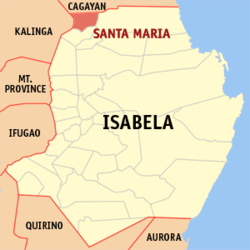Santa Maria, Isabela
Santa Maria (Ibanag: Ili nat Santa Maria; Ilocano: Ili ti Santa Maria; Tagalog: Bayan ng Santa Maria), officially the Municipality of Santa Maria, is a 4th class municipality in the province of Isabela, Philippines. According to the 2015 census, it has a population of 25,382 people.[3]
Santa Maria | |
|---|---|
| Municipality of Santa Maria | |
 Seal | |
| Nickname(s): Finest Pottery in Cagayan Valley | |
 Map of Isabela with Santa Maria highlighted | |
OpenStreetMap 
| |
.svg.png) Santa Maria Location within the Philippines | |
| Coordinates: 17°28′N 121°45′E | |
| Country | |
| Region | Cagayan Valley (Region II) |
| Province | Isabela |
| District | 1st District of Isabela |
| Barangays | 20 (see Barangays) |
| Government | |
| • Type | Sangguniang Bayan |
| • Mayor | Hilario G. Pagauitan |
| • Vice Mayor | Danilo S. Masigan |
| • Congressman | Antonio T. Albano |
| • Electorate | 16,731 voters (2019) |
| Area | |
| • Total | 140.00 km2 (54.05 sq mi) |
| Population (2015 census)[3] | |
| • Total | 25,382 |
| • Density | 180/km2 (470/sq mi) |
| • Households | 4,844 |
| Economy | |
| • Income class | 4th municipal income class |
| • Poverty incidence | 24.84% (2015)[4] |
| • Revenue (₱) | 75,672,052.32 (2016) |
| Time zone | UTC+8 (PST) |
| ZIP code | 3330 |
| PSGC | |
| IDD : area code | +63 (0)78 |
| Climate type | tropical rainforest climate |
| Native languages | Ibanag Ilocano Tagalog |
Barangays
Santa Maria is politically subdivided into 20 barangays. [2]
- Bangad
- Buenavista
- Calamagui North
- Calamagui East
- Calamagui West
- Divisoria
- Lingaling
- Mozzozzin Sur
- Mozzozzin North
- Naganacan
- Poblacion 1
- Poblacion 2
- Poblacion 3
- Quinagabian
- San Antonio
- San Isidro East
- San Isidro West
- San Rafael West
- San Rafael East
- Villabuena
Demographics
| Year | Pop. | ±% p.a. |
|---|---|---|
| 1903 | 3,252 | — |
| 1918 | 3,882 | +1.19% |
| 1939 | 5,794 | +1.93% |
| 1948 | 6,850 | +1.88% |
| 1960 | 9,705 | +2.95% |
| 1970 | 11,009 | +1.27% |
| 1975 | 12,417 | +2.44% |
| 1980 | 13,567 | +1.79% |
| 1990 | 16,767 | +2.14% |
| 1995 | 19,462 | +2.83% |
| 2000 | 20,115 | +0.71% |
| 2007 | 20,695 | +0.39% |
| 2015 | 25,382 | +2.58% |
| Source: Philippine Statistics Authority[3][5][6][7] | ||
In the 2015 census, the population of Santa Maria, Isabela, was 25,382 people,[3] with a density of 180 inhabitants per square kilometre or 470 inhabitants per square mile.
Climate
| Climate data for Santa Maria, Isabela | |||||||||||||
|---|---|---|---|---|---|---|---|---|---|---|---|---|---|
| Month | Jan | Feb | Mar | Apr | May | Jun | Jul | Aug | Sep | Oct | Nov | Dec | Year |
| Average high °C (°F) | 29 (84) |
30 (86) |
32 (90) |
35 (95) |
35 (95) |
35 (95) |
34 (93) |
33 (91) |
32 (90) |
31 (88) |
30 (86) |
28 (82) |
32 (90) |
| Average low °C (°F) | 19 (66) |
20 (68) |
21 (70) |
23 (73) |
23 (73) |
24 (75) |
23 (73) |
23 (73) |
23 (73) |
22 (72) |
21 (70) |
20 (68) |
22 (71) |
| Average precipitation mm (inches) | 31.2 (1.23) |
23 (0.9) |
27.7 (1.09) |
28.1 (1.11) |
113.5 (4.47) |
141.4 (5.57) |
176.4 (6.94) |
236.6 (9.31) |
224.9 (8.85) |
247.7 (9.75) |
222.9 (8.78) |
178 (7.0) |
1,651.4 (65) |
| Average rainy days | 10 | 6 | 5 | 5 | 13 | 12 | 15 | 15 | 15 | 17 | 16 | 15 | 144 |
| Source: World Weather Online[8] | |||||||||||||
gollark: What? You can surely just do separate games before a Host-recognized one.
gollark: Judge it by whether ominous recommender algorithms™ gave it to you, and a blurb.
gollark: Don't judge a book by its cover, LyricLy.
gollark: <@319753218592866315> I challenge you to be challenged in a challenging way.
gollark: That sounds good.
References
- "Municipality". Quezon City, Philippines: Department of the Interior and Local Government. Retrieved 31 May 2013.
- "Province: Isabela". PSGC Interactive. Quezon City, Philippines: Philippine Statistics Authority. Retrieved 12 November 2016.
- Census of Population (2015). "Region II (Cagayan Valley)". Total Population by Province, City, Municipality and Barangay. PSA. Retrieved 20 June 2016.
- "PSA releases the 2015 Municipal and City Level Poverty Estimates". Quezon City, Philippines. Retrieved 1 January 2020.
- Census of Population and Housing (2010). "Region II (Cagayan Valley)". Total Population by Province, City, Municipality and Barangay. NSO. Retrieved 29 June 2016.
- Censuses of Population (1903–2007). "Region II (Cagayan Valley)". Table 1. Population Enumerated in Various Censuses by Province/Highly Urbanized City: 1903 to 2007. NSO.
- "Province of Isabela". Municipality Population Data. Local Water Utilities Administration Research Division. Retrieved 17 December 2016.
- "Santa Maria, Isabela: Average Temperatures and Rainfall". World Weather Online. Retrieved 31 October 2015.
External links
- Santa Maria Profile at PhilAtlas.com
- Municipal Profile at the National Competitiveness Council of the Philippines
- Santa Maria at the Isabela Government Website
- Local Governance Performance Management System
- Philippine Standard Geographic Code
- Philippine Census Information
- Municipality of Santa Maria
This article is issued from Wikipedia. The text is licensed under Creative Commons - Attribution - Sharealike. Additional terms may apply for the media files.